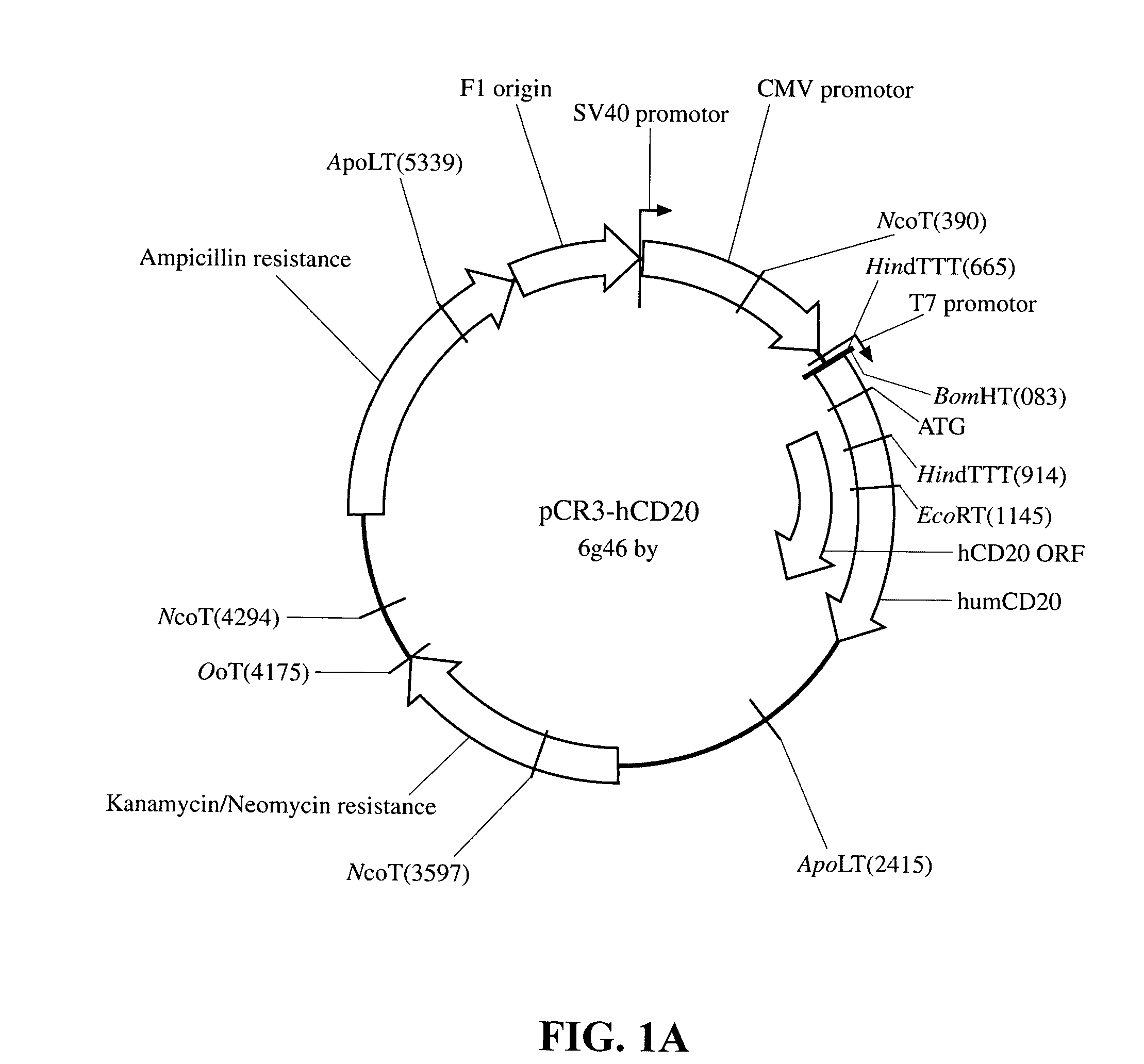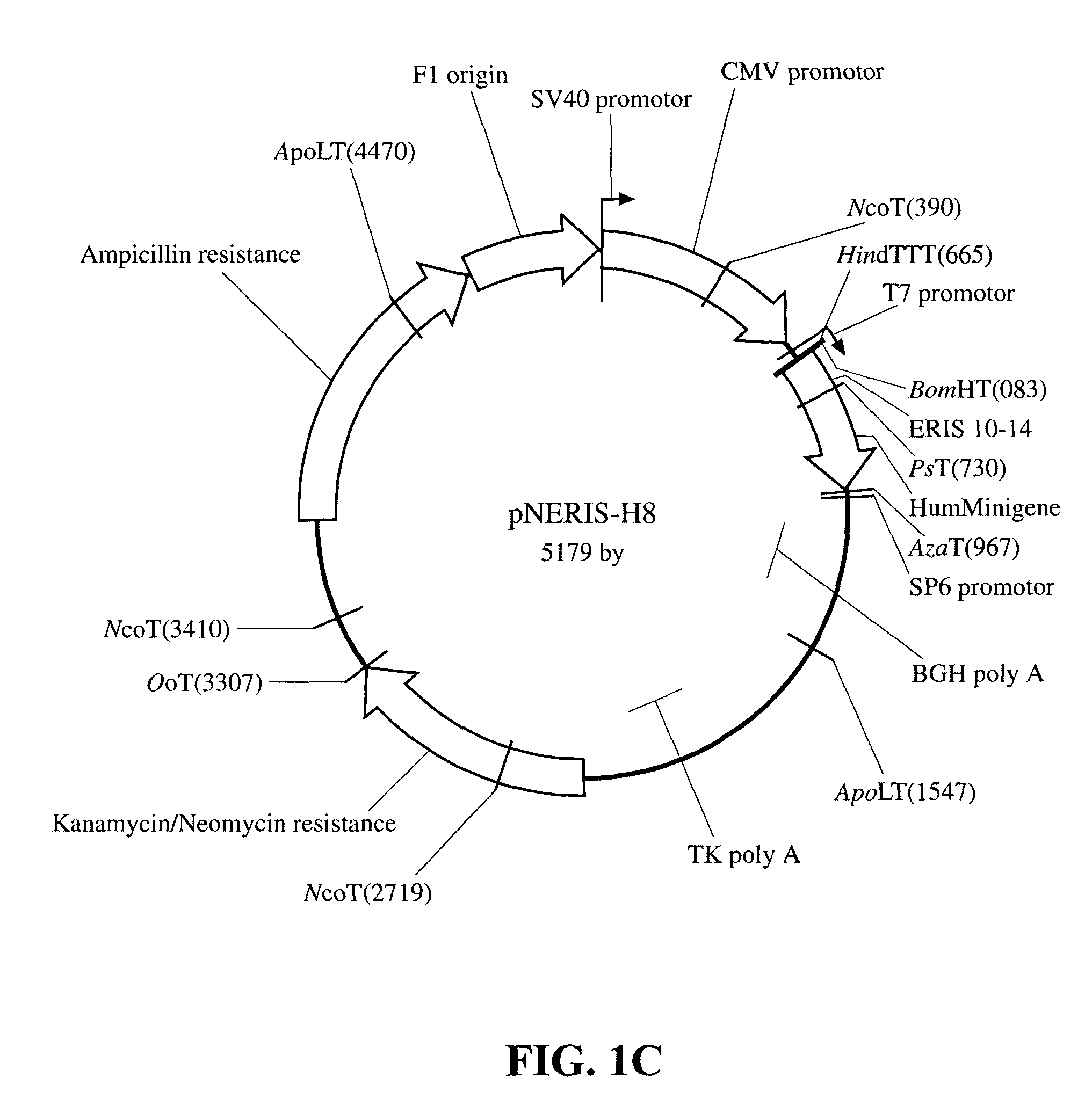Method and compositions for stimulation of an immune response to CD20 using a xenogeneic CD20 antigen
a technology of cd20 and composition, which is applied in the field of compositions for stimulating an immune response to cd20, can solve the problems of failure to mount an effective immune response, and achieve the effect of overcoming the tolerance of the immune system for endogenous cd20 and effective immunity
- Summary
- Abstract
- Description
- Claims
- Application Information
AI Technical Summary
Benefits of technology
Problems solved by technology
Method used
Image
Examples
example 1
Plasmid Construction:
[0028]Murine CD20 cDNA was obtained by RT-PCR from C57 / B6 mouse spleen and from A20 cells. The human counterpart was isolated from normal donor PBMC. Briefly, total RNA was extracted with Trizol reagent (InVitrogen, Carlsbad, Calif.) from 107 cells. The cDNA was synthesized using oligo dT primers and the DNAcycle kit (InVitrogen) as per the kit instructions. CD20 specific primers modified with appropriate restriction sites at the 5′ end (in both cases BamHI in the downstream primer and XbaI in the upstream primer) were as follows (all primers were synthesized by Operon, Alameda, Calif.): for the human cDNA the 5′ primer had the sequence 5′ATG GAT CCTGGA GGA AAT GCT GAG AG3′ (Seq. ID No. 1) and the 3′ primer 5′GGT CTA GAT GGT GCG TAT GTG CAG AG3′ (Seq. ID No. 2) and the resulting product measured 1158 bp and included 118 bp of 5′UTR, 894 bp of ORF and 130 bp of 3′UTR. The sequence of the 5′ and 3′ mouse primers were 5′AAG GAT CCA GTA CAC TGT AGC TAT CTT CAA GTA C...
example 2
[0029]For the construction of the minigenes, the inserts coding for the extracellular domain of CD20 were cloned by PCR into the plasmid pNERIS, in which the minigenes are expressed at the COOH-terminal of an endoplasmic reticulum (ER) insertion sequence derived from the adenovirus E3 / 19K glycoprotein, driven by the CMV promoter. The following primers were designed: the human downstream primer 5′CTA GCT GCA GTG TGC AGC GCC TCC CAT TTT TTA AAA ATG GAG AGT C3′ (Seq. ID No. 7) (Pstl site underlined, hCD20 sequence double underlined), and upstream primer 5′TGC TCG AGT CAA CAG TAT TGG GTA GAT GGG GAG3′ (Seq. ID No. 8)(Xhol site underlined, hCD20 sequence double underlined). The resulting product encodes the entire extracellular domain:
[0030]KISHFLKMESLNFIR AHTPYINIYNCEPANPSEKNSPSTQYCYS (44 aa, (Seq. ID No. 9)) under the regulation of the CMV promoter. The downstream primer 5′CTA GCT GCA GTG TGC AGC GCC TCT CAT TTT TTA AAA ATG AGA AGA C3′ (Seq. ID No. 10)(Pstl site underlined, hCD20 seque...
example 3
[0031]Transfections: BALB / c-3T3 cells were grown to 50-80% confluency. Cells were transfected using the Lipofectamine reagent (InVitrogen) and 1 g each of the plasmids pCR3, pCR3-hCD20, pCR3-mCD20, pNERIS-H8 and pNERIS-M8, as per the manufacturer's instructions. Cell were selected 48 hours after transfection with 1 mg / mL G418 (Gibco). Expression of the transfected DNA was tested by RT-PCR, using the same CD20-specific primers described in the previous section.
PUM
| Property | Measurement | Unit |
|---|---|---|
| body weight | aaaaa | aaaaa |
| acid | aaaaa | aaaaa |
| size | aaaaa | aaaaa |
Abstract
Description
Claims
Application Information
 Login to view more
Login to view more - R&D Engineer
- R&D Manager
- IP Professional
- Industry Leading Data Capabilities
- Powerful AI technology
- Patent DNA Extraction
Browse by: Latest US Patents, China's latest patents, Technical Efficacy Thesaurus, Application Domain, Technology Topic.
© 2024 PatSnap. All rights reserved.Legal|Privacy policy|Modern Slavery Act Transparency Statement|Sitemap



